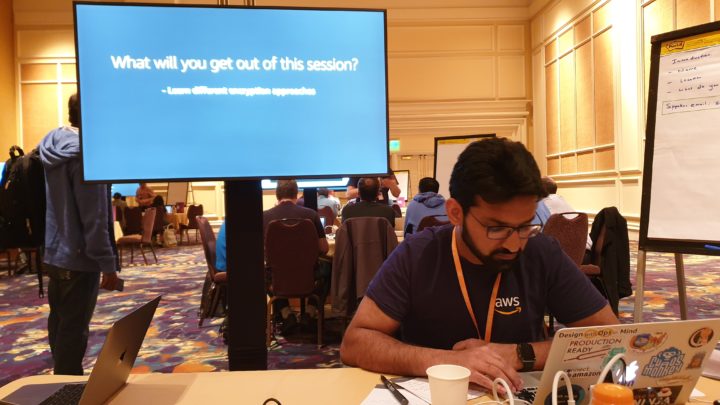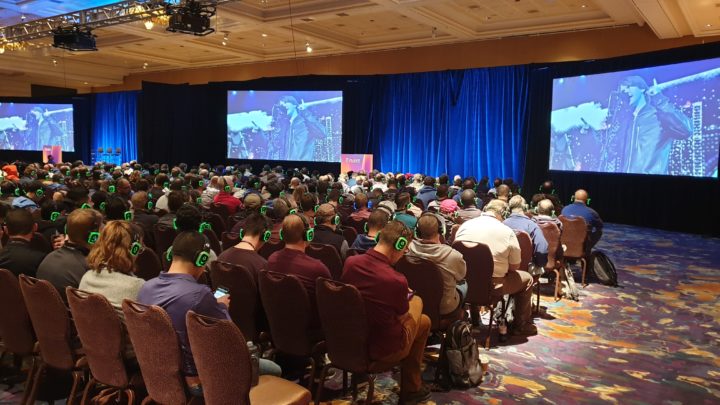My Tuesday at AWS re:Invent 2019
Please also check my blog post from Monday.
Starting from Tuesday each event venue provides great breakfast with lightning speed service. It scales and works. It’s always amazing how each venue can provide food services for thousands of people in short period of time. The most people are there for the first time so guidance has to be very clear and simple.
Today started with keynote by Mr. Andy Jassy. I was not able to join the live session at Venetian because of my next session. Moving from one location to another takes at least 15 minutes, and you have to be at least 10 minutes before at your session to reclaim you reserved seat. Starting last year, the booking systems forces one hour cap between sessions in different venues.
Keynote by Andy Jassy on Tuesday
You can find the full recap written by my colleagues here: Andy Jassy’s release roller coaster at AWS re:Invent 2019
Machine learning was the thing today. The Sagemaker service received tons of new features. Those are explained by our ML specialists here: Coming soon!
So I joined overflow room at Mirage for Jassy’s keynote session. Everyone has their personal headphones. I have more than 15 years background in software development, so it was love in first sight with CodeGuru. There are good news and bad news. It is service for static analysis of your code, to make review and finally but not definitely least to provide realtime profiling concept via installed agent.
The profiling information is provided in 5 minutes periods and it will provide profiling for several factors: CPU, memory and latency. It was promising product because Mr. Jassy told that Amazon has used it by itself for couple of years already. So, it is mature product already.
So, what was the bad news. It supports only Java. Nothing to add to that.
The other interesting announcement for me was general availability of Outposts. Finally, also in Europe you can have AWS fully managed servers inside your corporate datacenter. Those servers integrate fully to AWS Console and can be used eg. for running ECS container services. The starting price 8300 USD per month is very competitive because it already includes roughly 200 cores, 800GB memory and 2,7TB of instance storage. You can add EBS storage additionally starting from 2.7TB.
You can find more information here: https://aws.amazon.com/blogs/aws/aws-outposts-now-available-order-your-racks-today/
Performing analytics at the edge – IOT405
This session was a workshop and level 400 (highest). It was held by Mr. Sudhir Jena (Sr. IoT Consultant, AWS) and Mr. Rob Marano (Sr. Practice Manager, AWS).
Industry 4.0 a.k.a. IoT was totally new sector for me. It was very informative and pleasant session. It was all about AWS IoT Greengrass service which can provide low latency response but still managed platform which tons of features for handling data stream from IOT devices locally.
For multiple people it was first touch to AWS Cloud Development Kit which I fell in love about three months ago. It has multiple advances like refactoring, strong typing and good IDE support. You can find more information about AWS CDK here: https://docs.aws.amazon.com/cdk/latest/guide/home.html
In our workshop session we demonstrated to receive temperature, humidity etc. time series data stream from IoT device. The IoT device was in our case EC2 which simulated IoT device. From AWS IoT Greengrass console you can eg. deploy new version of analytic functions to the IoT devices.
Material for workshop can be found from Github: https://github.com/aws-samples/aws-iot-greengrass-edge-analytics-workshop
AWS Transit Gateway reference architectures for many VPCs – NET406
This was a session and it was held by Nick Matthews (Principal Solutions Architect, AWS) in glamorous Ballroom F at Mirage. It fits more than thousand people. The session was almost full, so it was a very popular session.
To summaries the topic, there are several good ways to do interconnectivity between multiple VPCs and corporate data center. In small scale you can things more manually but in large scale you need automation.
One provided solution for automation based on the use of tags. The autonomous team (owner of account A) can tag their shared resources predefined way. The transit account can read those changes via CloudTrail logging. So, each modification will create CloudTrail audit event which triggers lambda function. The function checks for if change is required and makes change request item to metadata table in DynamoDB to wait for approval. The network operator is notified via SNS (Simple notification service). The operator can then allow (or decline) the modification. Another Lambda will then do the needed route table modifications for the transit account and for the account A.
If you are interested, you can watch video from August 2019: https://pages.awscloud.com/AWS-Transit-Gateway-Reference-Architectures-for-Many-Amazon-VPCs_2019_0811-NET_OD.html
If you want to wait, I’m pretty sure that this re:Invent talk was also recorded and can be found from AWS Youtube channel in few week: https://www.youtube.com/user/AmazonWebServices
Fortifying web apps against bots and scrapers with AWS WAF – SEC357
Mr. Yuri Duchovny (Solution architect, AWS) held the session. It was the most intensive session with a lots of todo with many architectural examples and usage scenarios in demo screen. The AWS WAF service has got a new shiny UI in AWS Console. Also the AWS published few new features already in last few weeks, eg. Managed rules to give more protection in nondisruptive way. The WAF it self did not have multiple predefined rules for protection, only XSS (Cross-site Scripting) an SQLi (SQL Injection) were supported. All other rules needed to configure manually as regular expressions or so.
The WAF is service that should always be turned on for CloudFront Distribution, Application Load Balancer (ALB) and API Gateway.
The workshop material is again public and can be found from here: https://github.com/gtaws/ProtectWithWAF
Encryption options for AWS Direct Connect – NET405
Mr. Sohaib Tahir (Sr Solutions Architect, AWS) from Seattle was the teacher in this session. It was more listening than doing because of the short period of time. We (attendees) were group of seven from USA, Japan and Finland.

There was five possibilities to encrypt direct connection:
1. Private VIF (virtual interface) + application-layer TLS
2. Private VIF + virtual VPN appliances (can be in transit VPC)
3. Private VIF + detached VGW + AWS Site-to-site VPN (CloudHub functionality)
4. Public VIF + AWS Virtual Private Gateway (GP, IPSec tunnel, BGP)
5. Public VIF + AWS Transit Gateway (BGP, IPSec tunnel, BGP) NEW!
It’s good to remember that single VPN connections has 1,25 Gbps limit which can be hit easily with DX connection and eg. data intensive migration jobs. AWS recommendation is to use number five architecture if it is possible. Using the fifth architecture requires to have own direct connection so you cannot use shared model direct connection from 3rd party operator.
AWS published yesterday cross-region VPC connectivity via Transit Gateway. During the session Mr. Tahir started to do demonstrate this new feature ad-hoc but we ran out of time.



